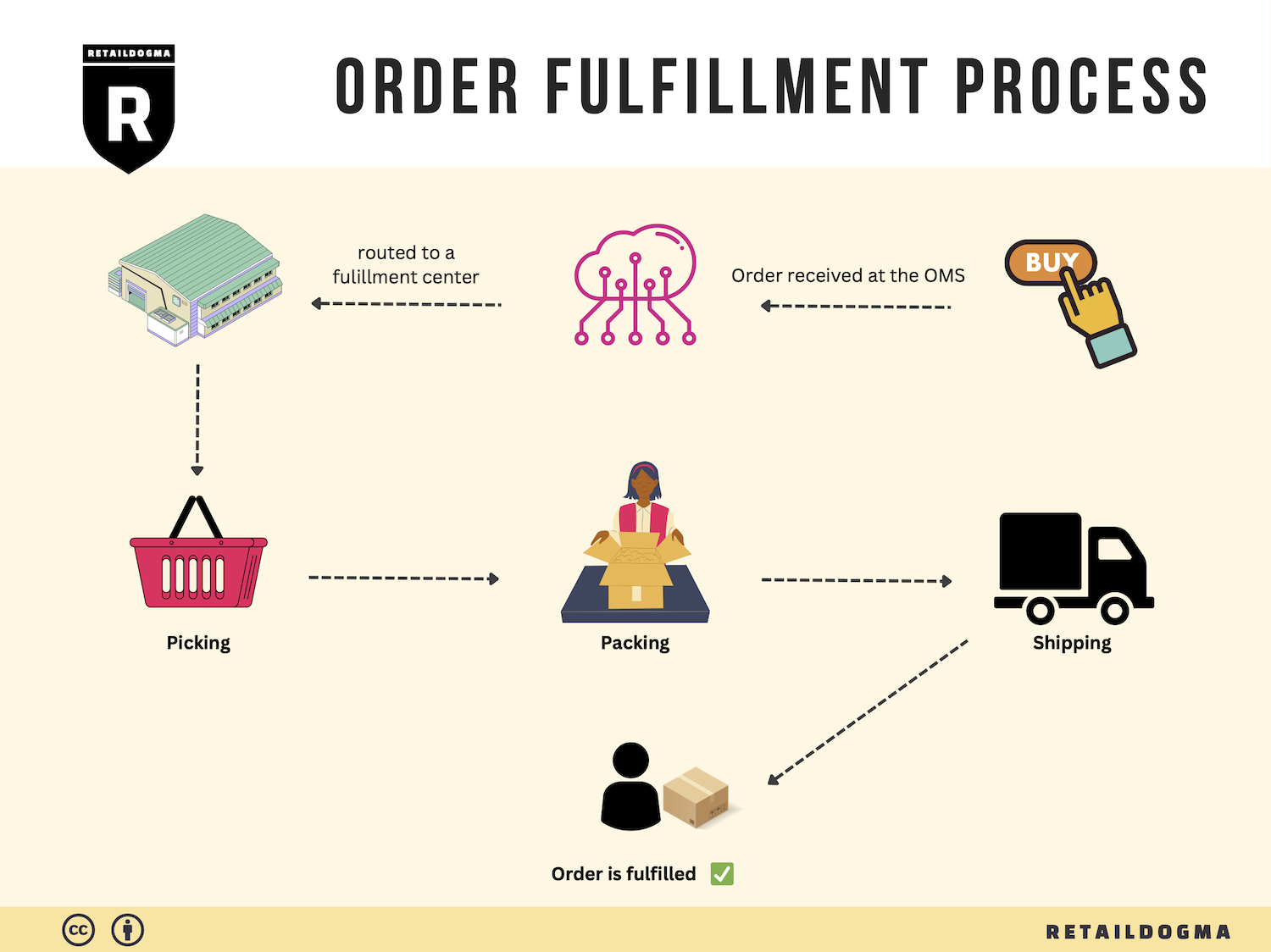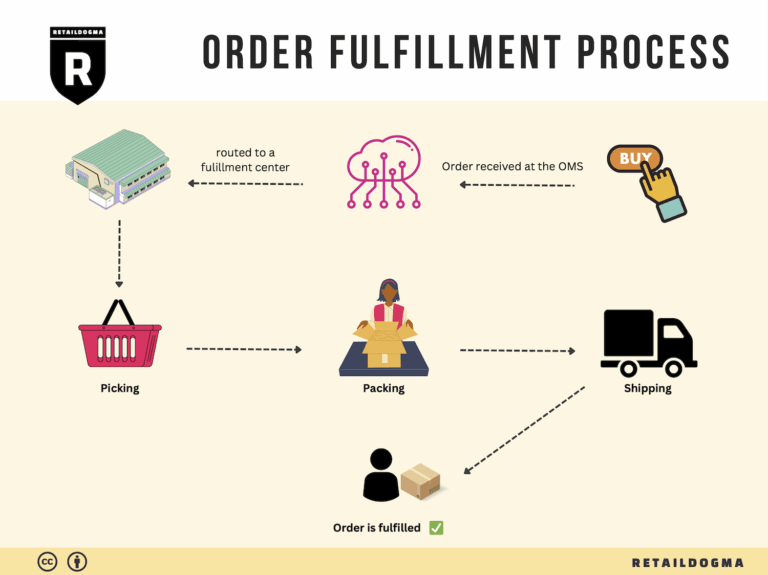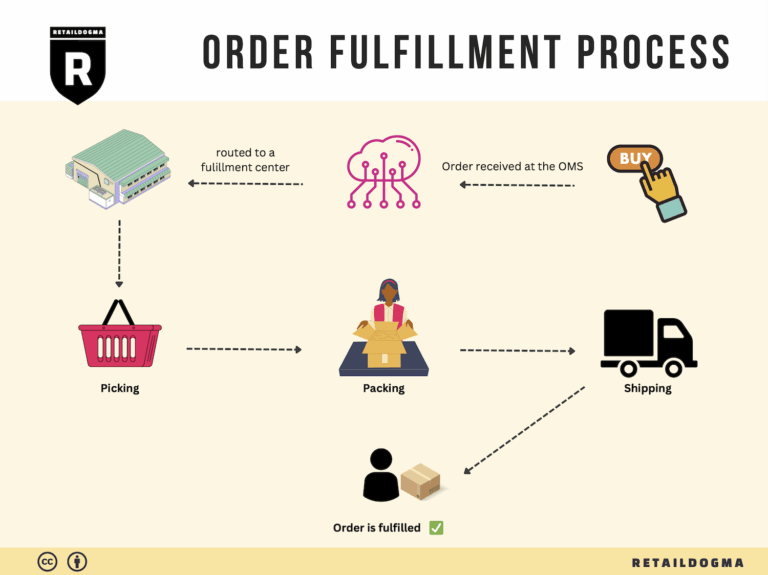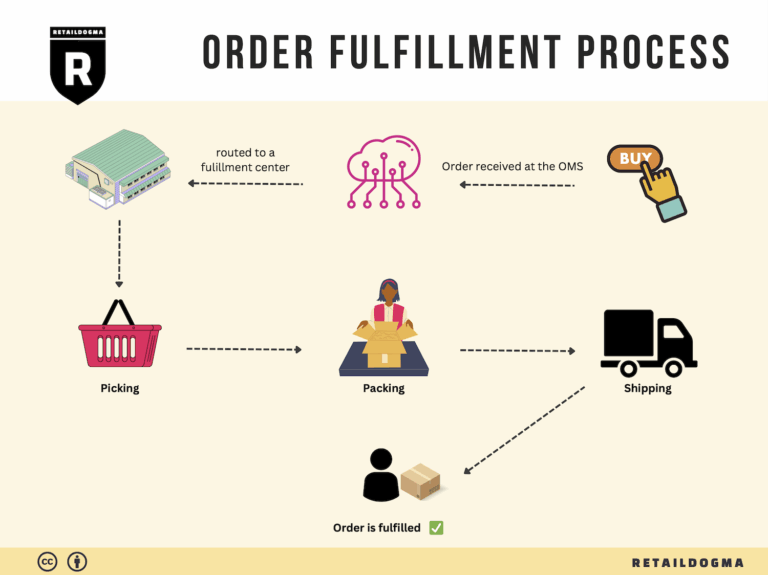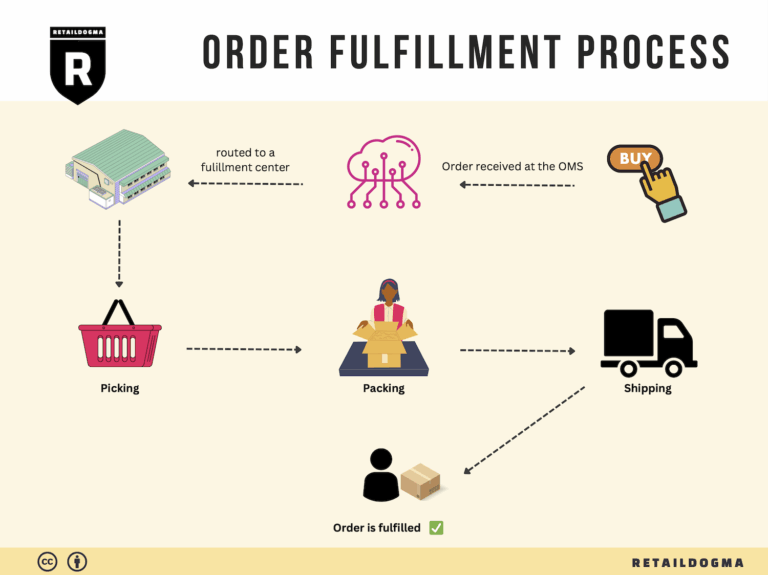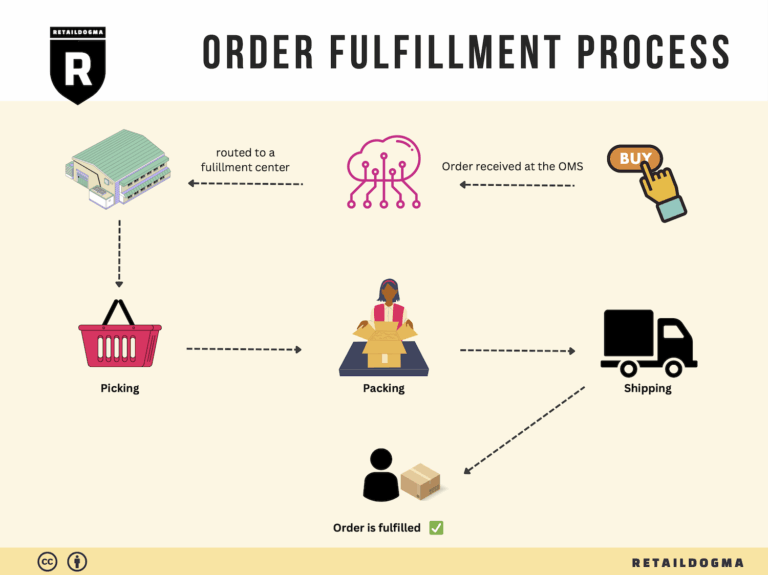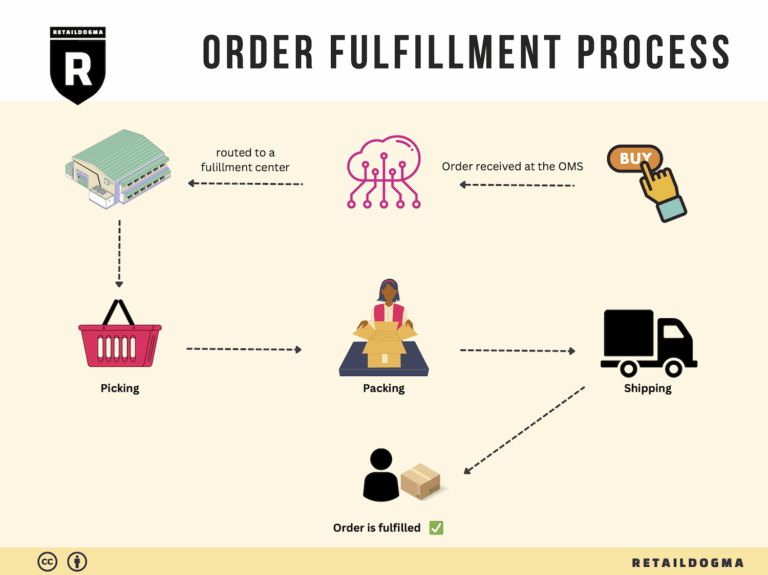How Order Fulfillment Works: A Step-by-Step Guide for Businesses
What is E-commerce Fulfillment? An Introduction for Growing Businesses
Understanding E-commerce Fulfillment
For many growing online businesses, the thrill of increasing sales can quickly turn into a daunting challenge when it comes to packing and shipping orders. As your customer base expands, so does the complexity of managing logistics. The process of getting a product from your warehouse to your customer’s doorstep is known as fulfillment, and it is a crucial aspect of e-commerce that can significantly impact customer satisfaction and your bottom line.
Fulfillment encompasses all the steps involved in receiving, processing, and delivering orders. This includes inventory management, order processing, packing, shipping, and handling returns. As your business scales, the need for an efficient fulfillment strategy becomes paramount. However, navigating the various fulfillment options can be overwhelming.
In this guide, we will explore the different models of e-commerce fulfillment that can help streamline your operations. From third-party logistics (3PL) providers to Amazon’s Fulfillment by Amazon (FBA), each model offers unique advantages and challenges. Understanding these options will enable you to choose the right approach for your business.
We will also delve into the core services offered by fulfillment partners, including storage solutions, order tracking, and customer support. Knowing what to expect from a fulfillment partner can help you make informed decisions about your logistics strategy.
Choosing the right fulfillment partner is critical for your business’s success. We will provide you with practical advice on what to look for in a partner, including their technology capabilities, shipping options, and customer service standards. Additionally, we will discuss pricing structures, helping you to evaluate the cost-effectiveness of various fulfillment solutions.
Ultimately, this guide aims to empower e-commerce business owners, operations managers, and entrepreneurs with the knowledge they need to make smart decisions about their logistics. By understanding the landscape of e-commerce fulfillment, you can optimize your operations, enhance customer satisfaction, and position your business for sustainable growth in the competitive online marketplace.
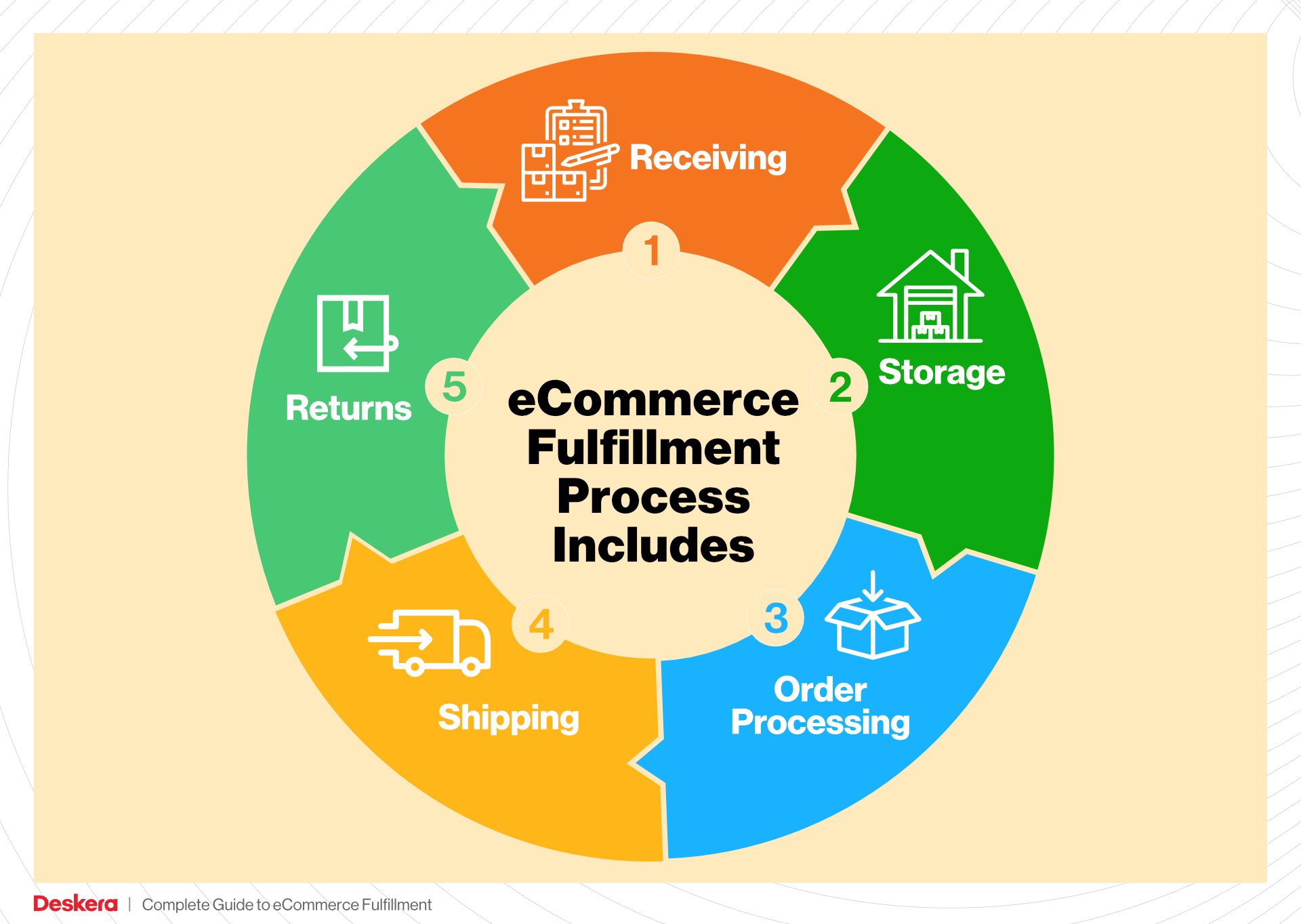
What You’ll Learn In This Guide
- What is E-commerce Fulfillment? An Introduction for Growing Businesses
- The Order Fulfillment Process: From ‘Buy’ Button to Customer’s Door
- Comparing Fulfillment Models: In-House vs. 3PL vs. Dropshipping
- A Deep Dive into Amazon FBA: Pros, Cons, and Who It’s For
- Core Services Offered by Fulfillment Centers
- How to Choose a Fulfillment Partner: A 6-Point Checklist
- Understanding Fulfillment Pricing: A Breakdown of Common Fees
- Frequently Asked Questions (FAQs) about Fulfillment
- Conclusion: Is Outsourcing Fulfillment the Right Move for Your Business?
- Important Disclaimer
The Order Fulfillment Process: From ‘Buy’ Button to Customer’s Door
1. Receiving Inventory
The first step in the order fulfillment process is receiving inventory. This involves the delivery of products to the warehouse or fulfillment center, where they are checked for quality and quantity against purchase orders. Each item is assigned a unique identifier known as a Stock Keeping Unit (SKU), which helps in tracking inventory levels and facilitating accurate order fulfillment.
Importance: Proper inventory reception is crucial for maintaining accurate stock levels, reducing discrepancies, and ensuring that only quality products are stored. If inventory is not received correctly, it can lead to stockouts or overstock situations, both of which can significantly impact sales and customer satisfaction.
Key Term: SKU (Stock Keeping Unit) – A unique identifier for each product, used for tracking inventory.
2. Warehouse Storage
Once the inventory is received and verified, the next step is warehouse storage. Products are organized and placed in designated storage areas within the fulfillment center. This can include shelves, bins, or pallets, depending on the size and nature of the items. Effective warehouse layout and organization are essential for optimizing space and improving efficiency.
Importance: Efficient storage solutions minimize the time taken to locate products during order picking. A well-organized warehouse also helps in maximizing space utilization and can reduce operational costs. Additionally, proper storage practices help to prevent damage and deterioration of products.
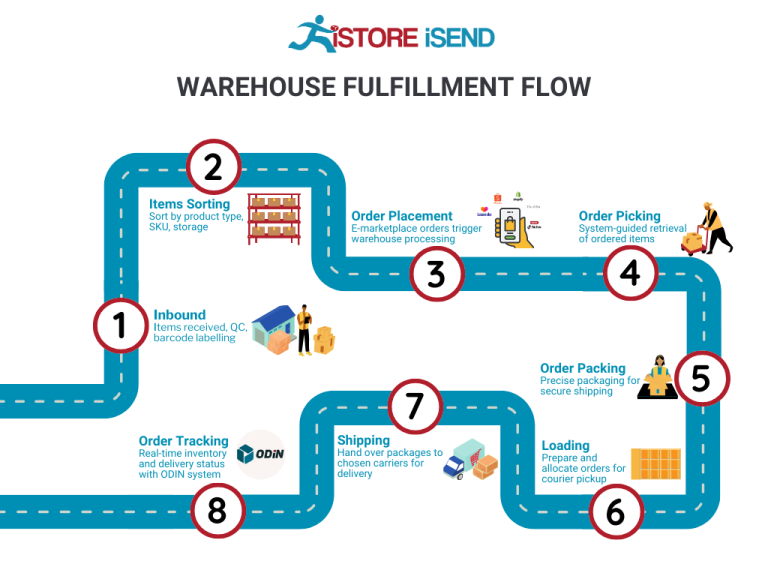
Key Term: ABC Analysis – A method for categorizing inventory based on importance and turnover rates, helping to optimize storage space.
3. Order Picking
Order picking is the process where items are retrieved from storage to fulfill customer orders. Employees or automated systems use pick lists, which detail the items and quantities required for each order. The picking process can be done in various ways, including single order picking, batch picking, or zone picking, depending on the volume and nature of the orders.
Importance: The efficiency of the picking process directly affects the speed of order fulfillment. Faster picking leads to quicker order processing and improved customer satisfaction. Moreover, accurate picking is vital to ensure that customers receive the correct products, thereby reducing return rates and enhancing brand trust.
Key Term: Pick List – A document or digital tool that outlines the items needed to fulfill a specific order.
4. Order Packing
After the items are picked, they must be packed securely for shipment. This involves selecting appropriate packaging materials and methods to protect the items during transit. Packing stations are typically equipped with tools such as tape dispensers, scales, and labeling machines to facilitate this process.
Importance: Proper packing is essential to prevent damage during shipping and to ensure that products arrive in excellent condition. Additionally, effective packing helps in optimizing shipping costs by reducing dimensional weight and ensuring compliance with carrier requirements. A well-packed order can enhance the unboxing experience for customers, fostering brand loyalty.
Key Term: Dimensional Weight – A pricing technique used by shipping carriers based on the dimensions of a package rather than its actual weight.
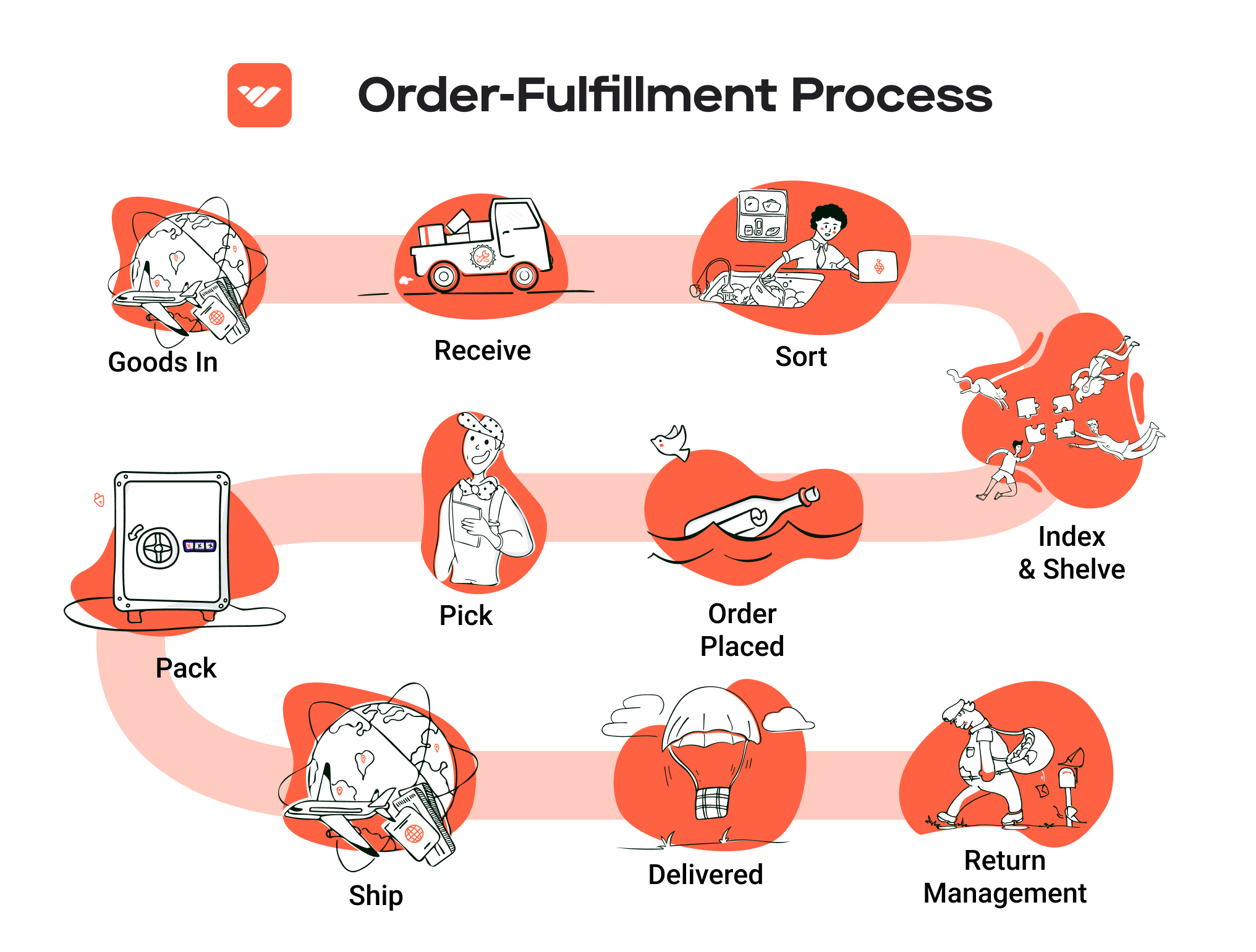
5. Shipping & Delivery
The final step in the order fulfillment process is shipping and delivery. Once an order is packed, it is labeled and handed over to a carrier for transportation. Businesses often choose between various shipping options based on cost, speed, and customer preferences. Last-mile delivery, which involves transporting packages from a distribution center to the final destination, is particularly critical in urban areas like New York City.
Importance: Efficient shipping and delivery systems are crucial for meeting customer expectations regarding delivery times. Offering multiple shipping options can enhance customer satisfaction and drive repeat purchases. Additionally, optimizing logistics helps in reducing shipping costs, which can improve overall profitability.
Key Term: Last-Mile Delivery – The final step of the delivery process where the package is transferred from a transportation hub to the end customer.
By mastering each step of the order fulfillment process, e-commerce businesses can enhance their operational efficiency, improve customer satisfaction, and ultimately scale their logistics capabilities effectively.
Comparing Fulfillment Models: In-House vs. 3PL vs. Dropshipping
Comparing Fulfillment Models
| Model | Who Handles Inventory | Best For (Business Stage) | Key Advantage | Key Disadvantage |
|---|---|---|---|---|
| In-House Fulfillment | Business itself | Established businesses | Greater control over inventory and fulfillment | Higher overhead costs and labor requirements |
| Third-Party Logistics (3PL) | Third-party logistics provider | Growing businesses seeking scalability | Access to expertise and reduced operational burdens | Less control over fulfillment and potential service variability |
| Dropshipping | Supplier/manufacturer | Startups and small businesses | Low overhead and no inventory risk | Lower profit margins and reliance on supplier reliability |
In-House Fulfillment
In-house fulfillment involves managing the entire logistics process within the company itself. This includes storage, inventory management, order processing, and shipping. Businesses that choose this model typically have established operations and sufficient capital to invest in warehousing, staff, and technology. One of the main advantages of in-house fulfillment is the enhanced control it provides over inventory and fulfillment processes. Companies can tailor their operations to meet specific customer needs, ensuring faster response times and potentially higher customer satisfaction. However, this model also has significant drawbacks, including higher overhead costs associated with staffing, warehousing, and equipment. Additionally, as demand fluctuates, businesses may find themselves overstaffed or under-resourced, leading to inefficiencies.
Third-Party Logistics (3PL)
Third-party logistics (3PL) providers offer a comprehensive suite of services that can include warehousing, inventory management, order fulfillment, and shipping. Businesses that opt for 3PL are typically in a growth phase, looking to scale their operations without the burden of managing logistics themselves. The key advantage of using a 3PL is that it allows businesses to leverage the provider’s expertise and infrastructure, reducing operational burdens and allowing the company to focus on core activities like marketing and product development. This can lead to improved efficiency and cost-effectiveness. However, a notable downside is the potential loss of control over the fulfillment process. Businesses must rely on the 3PL to maintain service quality and reliability, which can vary between providers. Additionally, transitioning to a 3PL can involve complex integration with existing systems and processes.
Dropshipping
Dropshipping is a fulfillment model where the retailer does not keep products in stock but instead transfers customer orders directly to a supplier or manufacturer, who then ships the products directly to the customer. This model is particularly suited for startups and small businesses looking to minimize upfront investment and inventory risk. The primary advantage of dropshipping is the low overhead; businesses can operate without the need for warehousing or significant capital tied up in inventory. This allows for greater flexibility in product offerings and the ability to pivot quickly based on market demands. However, dropshipping also comes with challenges, such as lower profit margins due to reliance on suppliers and potential issues with order fulfillment and quality control. Retailers must ensure that their suppliers are reliable and can meet shipping and quality expectations, as any shortcomings can directly impact customer satisfaction and brand reputation.
Conclusion
Choosing the right fulfillment model is crucial for the success and scalability of an e-commerce business. Each model presents unique advantages and challenges that need to align with the company’s operational capabilities, customer expectations, and long-term growth objectives. As businesses evolve, they may find it beneficial to reassess their fulfillment strategies, potentially transitioning from one model to another as their needs change. Understanding these models in the context of the competitive landscape, especially in logistics hubs like New York City, can provide valuable insights for making informed decisions about fulfillment operations.
A Deep Dive into Amazon FBA: Pros, Cons, and Who It’s For
Understanding Fulfillment by Amazon (FBA)
Fulfillment by Amazon (FBA) is a service provided by Amazon that allows sellers to store their products in Amazon’s fulfillment centers. Once a customer places an order, Amazon takes care of storage, packaging, and shipping the product directly to the customer. This service enables sellers to leverage Amazon’s extensive logistics network and customer service capabilities, ultimately enhancing their sales potential.
How FBA Works
-
Setting Up: Sellers create an Amazon seller account and enroll in the FBA program. They then prepare their products according to Amazon’s guidelines, which include labeling and packaging requirements.
-
Shipping to Amazon: Once the products are ready, sellers ship them to Amazon’s fulfillment centers. Amazon has numerous warehouses across the United States, including a significant presence in the New York City area, which is crucial for quick delivery.
-
Storage and Inventory Management: Amazon stores the products in its fulfillment centers. Sellers can monitor their inventory levels via the Amazon Seller Central dashboard, ensuring they maintain optimal stock levels.
-
Order Fulfillment: When a customer places an order, Amazon picks, packs, and ships the product. Amazon also handles customer service and returns, allowing sellers to focus on other aspects of their business.
-
Fees: Sellers pay various fees for using FBA, including storage fees (for storing products) and fulfillment fees (for each unit sold). It’s essential for sellers to understand these fees to maintain profitability.
Pros of Using FBA
1. Prime Eligibility
Products fulfilled through FBA are eligible for Amazon Prime, which attracts millions of customers who prioritize fast and free shipping. This can significantly boost sales as Prime members are more likely to purchase items that qualify for their membership benefits.
2. Customer Trust
Amazon has built a reputation for reliability and customer service. By using FBA, sellers can benefit from this trust. Customers often prefer buying from sellers that use FBA, as they know they will receive their items promptly and have easy access to Amazon’s customer service.
3. Multi-Channel Fulfillment
FBA allows sellers to fulfill orders not just from Amazon but also from other sales channels, such as eBay or their own websites. This flexibility can streamline operations and help sellers manage their inventory more effectively across different platforms.
4. Simplified Logistics
Using FBA simplifies the logistics process, as sellers do not need to worry about warehousing, packing, or shipping. This can be particularly advantageous for small businesses that may not have the resources to manage these logistics independently.
5. Scalability
FBA enables businesses to scale quickly. As demand for products increases, sellers can rely on Amazon’s infrastructure to handle larger volumes without needing to invest in additional warehousing or staffing.
Cons of Using FBA
1. High Fees
One of the most significant drawbacks of FBA is the cost. Sellers must pay various fees, including storage fees (which can add up, especially for long-term storage) and fulfillment fees for each item sold. For some sellers, these costs can erode profit margins.
2. Strict Inventory Rules
Amazon has stringent rules regarding inventory management, including limits on how much stock can be sent to their warehouses. Sellers must stay vigilant about their inventory levels and manage their stock effectively to avoid penalties.
3. Commingling Risks
FBA operates on a commingling model, meaning that products from different sellers may be stored together. This can pose risks for sellers, as customers may receive items from other sellers that could affect their brand reputation. For example, if a customer receives a defective product, it can lead to negative reviews that impact the original seller’s account.
4. Limited Control Over Fulfillment
While FBA offers convenience, sellers relinquish some control over the fulfillment process. This can be challenging for businesses that have specific packaging or shipping requirements. Additionally, sellers may encounter delays due to Amazon’s operational decisions.
5. Potential for Inventory Loss
There is always a risk of inventory loss or damage while stored in Amazon’s warehouses. Though Amazon has policies in place to handle these situations, the potential for lost items can be a concern for sellers.
Who is FBA Best For?
Fulfillment by Amazon is particularly advantageous for:
- Small to Medium-Sized Businesses: Sellers who lack the infrastructure to manage logistics can benefit greatly from FBA’s comprehensive services.
- New Sellers: Those just starting can leverage FBA to quickly gain exposure and trust on the platform without significant upfront investment in logistics.
- Retailers Seeking Scalability: Businesses looking to scale their operations without investing heavily in warehousing and fulfillment can utilize FBA to manage increased demand.
- E-commerce Entrepreneurs: Individuals looking to diversify their sales channels can use FBA to fulfill orders from multiple platforms efficiently.
- Brands with High Turnover Products: Sellers with fast-moving products can benefit from the quick shipping times and increased visibility associated with FBA.
In conclusion, while Fulfillment by Amazon presents certain challenges, its benefits often outweigh the drawbacks for many sellers. Understanding how FBA works and weighing the pros and cons can help e-commerce business owners make informed decisions about their fulfillment strategies.
Core Services Offered by Fulfillment Centers
Inventory Management & Warehousing
Inventory management and warehousing form the backbone of any fulfillment center’s operations. This service involves the systematic tracking and storage of products in a facility, ensuring that businesses can manage their stock levels efficiently. Fulfillment centers utilize sophisticated inventory management systems that offer real-time visibility into stock levels, allowing e-commerce businesses to make informed decisions about reordering and stock rotation.
The benefits of effective inventory management are manifold. For e-commerce businesses, it minimizes the risks of overstocking or stockouts, both of which can have significant financial implications. Overstocking ties up capital in unsold goods, while stockouts can lead to lost sales and diminished customer satisfaction. Additionally, advanced warehousing solutions often include climate control and specialized storage options for perishable or fragile items, ensuring that products are stored under optimal conditions.
Moreover, with the rise of e-commerce in densely populated areas like New York City, fulfillment centers are increasingly adopting multistory warehouse designs to maximize space. This not only enables businesses to store more products closer to their customer base, reducing shipping times, but also enhances operational efficiency through optimized layout and workflow management.
Pick and Pack Services
Pick and pack services are critical to fulfilling customer orders accurately and efficiently. This process involves selecting the right products from inventory (picking) and packaging them appropriately for shipment (packing). Fulfillment centers employ trained staff and automated systems to streamline this process, ensuring that orders are fulfilled quickly and correctly.
The primary benefit of pick and pack services lies in their impact on order accuracy and speed. Accurate order fulfillment is essential for maintaining customer trust and satisfaction; errors can lead to returns and negative reviews, which are particularly damaging for emerging e-commerce businesses. By utilizing fulfillment centers, businesses can leverage their expertise and technology to enhance accuracy.
Speed is another crucial factor. In today’s fast-paced e-commerce environment, customers expect quick delivery times. Fulfillment centers are designed to optimize pick and pack operations, often employing techniques such as batch picking and zone picking to expedite the process. This efficiency translates to quicker shipping times, allowing businesses to meet customer expectations and gain a competitive edge.
Kitting and Assembly
Kitting and assembly services involve the grouping of individual items into ready-to-ship sets or the assembly of products before they are sent to customers. This service is particularly useful for businesses that offer bundles, promotional items, or complex products requiring assembly before shipping.
The benefits of kitting and assembly are significant. For e-commerce businesses, it simplifies the order fulfillment process by reducing the number of individual items that need to be picked and packed. Instead of fulfilling multiple individual orders, fulfillment centers can prepare a single kit, streamlining operations and reducing labor costs.
Additionally, kitting allows businesses to create unique product offerings that can enhance customer value. For instance, a beauty brand can bundle skincare products into a themed kit, appealing to customers looking for convenient purchasing options. This not only boosts sales but also enhances the brand’s image as a provider of curated experiences. Fulfillment centers equipped for kitting and assembly can handle these operations efficiently, freeing up time for business owners to focus on marketing and customer engagement.
Returns Management (Reverse Logistics)
Returns management, often referred to as reverse logistics, is a vital service offered by fulfillment centers that deals with the return of products from customers back to the warehouse. This process includes handling returns, inspecting products, restocking items, and managing any necessary repairs or refurbishments.
The importance of effective returns management cannot be overstated. In the e-commerce landscape, where customer satisfaction and retention are paramount, a smooth returns process can significantly enhance customer loyalty. Customers are more likely to shop with a business that offers hassle-free returns, as it reduces the perceived risk of purchasing online.
Fulfillment centers streamline the returns process by employing dedicated teams and technology to manage returns efficiently. They can quickly assess the condition of returned items and determine the best course of action—whether to restock, refurbish, or recycle. This not only minimizes losses from returned goods but also helps businesses maintain accurate inventory levels.
Moreover, effective reverse logistics can provide valuable insights into customer preferences and product performance. By analyzing return data, e-commerce businesses can identify trends, adjust their offerings, and improve product descriptions, ultimately enhancing the overall shopping experience.
In conclusion, partnering with a fulfillment center that offers these core services can significantly enhance an e-commerce business’s operational efficiency, customer satisfaction, and scalability. By leveraging the expertise and resources of fulfillment centers, businesses can focus on growth and innovation, confident that their logistics and supply chain operations are in capable hands.
How to Choose a Fulfillment Partner: A 6-Point Checklist
Location & Warehouse Network
Choosing a fulfillment partner begins with understanding their location and the strength of their warehouse network. Proximity to your customer base can significantly reduce shipping times and costs, enhancing customer satisfaction and loyalty.
Why It Matters:
– Reduced shipping times lead to faster delivery, which is increasingly critical in today’s e-commerce landscape.
– A well-distributed network can help mitigate risks associated with natural disasters or other disruptions.
Questions to Ask:
1. Where are your warehouses located, and how do they align with my target market?
2. Do you have multiple facilities to ensure redundancy and faster shipping?
3. What transportation methods do you use to distribute products from your warehouses?
Technology & Integrations
In a technology-driven e-commerce environment, the capabilities of your fulfillment partner’s systems can make or break your operations. Robust technology and seamless integrations with your existing platforms can enhance efficiency and accuracy.
Why It Matters:
– Advanced software can provide real-time inventory management, order tracking, and analytics to optimize your supply chain.
– Integrations with e-commerce platforms (like Amazon, Shopify, etc.) are essential for streamlining order processing.
Questions to Ask:
1. What software do you use for inventory management, and how does it integrate with my systems?
2. Can you provide real-time tracking for orders and inventory levels?
3. Are there APIs available for custom integrations?
Specializations (e.g., Cold Storage, Oversized Items)
Different businesses have unique needs, and selecting a fulfillment partner that specializes in your specific requirements can improve service quality and efficiency.
Why It Matters:
– If your products require special handling (like cold storage for perishables or oversized items), a partner with relevant expertise can ensure compliance and care.
– Specialized services can reduce the risk of damage and improve customer satisfaction.
Questions to Ask:
1. Do you have experience handling products similar to mine?
2. What specialized services do you offer, and how do you ensure compliance with relevant regulations?
3. Can you provide case studies or references for similar businesses you have supported?
Scalability & Capacity
As your business grows, your fulfillment partner must be able to scale operations accordingly. A partner with scalable solutions can help you adapt to fluctuations in demand without compromising service quality.
Why It Matters:
– A partner that cannot scale with your growth can lead to delays, stockouts, or increased costs.
– Flexibility in capacity allows for seasonal spikes and unexpected demand surges.
Questions to Ask:
1. How do you handle increased order volumes during peak seasons?
2. What is your capacity for scaling operations, and how quickly can you respond to growth?
3. Can you provide examples of how you have scaled services for other clients?
Pricing and Contracts
Understanding the pricing structure and contract terms is crucial to maintaining your budget and ensuring a good return on investment. Transparency in pricing can prevent unexpected costs down the line.
Why It Matters:
– A clear pricing model helps you forecast expenses and plan your budget effectively.
– Flexible contract terms can provide the agility needed to adapt to changing business conditions.
Questions to Ask:
1. Can you outline your pricing structure, including any hidden fees?
2. What are the terms of the contract, and how do you handle contract renewals?
3. Are there any penalties for early contract termination or underperformance?
Customer Support & Reviews
The level of customer support provided by a fulfillment partner can significantly affect your operations. Additionally, reviews and feedback from other businesses can give you insight into the partner’s reliability and service quality.
Why It Matters:
– Excellent customer support can resolve issues quickly, minimizing disruptions to your business.
– Positive reviews and testimonials can indicate a partner’s reliability and commitment to customer satisfaction.
Questions to Ask:
1. What customer support channels do you offer (e.g., phone, email, chat)?
2. How quickly can I expect a response to inquiries or issues?
3. Can you provide references or case studies from current or past clients?
Conclusion
Selecting the right fulfillment partner is a critical decision that can significantly impact your e-commerce business’s growth and success. By following this checklist, you can ensure that you evaluate potential partners comprehensively and choose one that aligns with your operational needs and long-term goals. Remember that the right partner will not only fulfill your orders but also contribute to your overall customer experience and business strategy.
Understanding Fulfillment Pricing: A Breakdown of Common Fees
Initial Setup Fees
When partnering with a fulfillment center, the initial setup fees are often one of the first costs you will encounter. These fees cover the necessary administrative processes to onboard your business into the fulfillment system. They may include costs associated with creating your account, integrating your e-commerce platform with the fulfillment center’s software, and setting up any required inventory management systems.
Typically, initial setup fees can range from a few hundred to several thousand dollars, depending on the complexity of your operations. For instance, if you are integrating multiple sales channels or require custom configurations, expect to pay higher fees. To manage these costs effectively, ensure you understand what is included in the setup process and consider negotiating terms based on your specific needs.
Receiving Fees
Receiving fees are charged when your products arrive at the fulfillment center. These fees cover the labor and resources required to unload, inspect, and store your inventory. They can be calculated on a per-unit basis or as a flat fee depending on the fulfillment provider’s policies.
For example, a fulfillment center might charge $0.25 per item received or a flat rate for a truckload of goods. It’s crucial to clarify how these fees are structured, as they can vary significantly between providers. Additionally, if your inventory arrives in bulk or requires special handling, expect to pay higher receiving fees. To minimize these costs, try to consolidate shipments and ensure your products are packaged efficiently to facilitate quicker unloading.
Storage Fees (per pallet/bin)
Storage fees are charged for the physical space your inventory occupies within the warehouse. This fee can be calculated either per pallet or per bin, depending on how the fulfillment center organizes its storage. In high-demand areas like New York City, where warehouse space is at a premium, these fees can be particularly significant.
Typically, storage fees are billed monthly and can range from $10 to $30 per pallet or $0.50 to $2.00 per bin, depending on the fulfillment center’s location and the volume of your goods. To manage storage costs, consider using just-in-time inventory practices, which minimize the amount of stock held at the fulfillment center. Additionally, regularly review your inventory turnover rates to ensure you aren’t paying for storage on slow-moving items.
Pick & Pack Fees (per item/order)
Pick and pack fees are incurred each time an order is processed. These fees cover the costs associated with selecting the items from storage (picking) and preparing them for shipment (packing). The structure of these fees can vary; some fulfillment centers charge a flat rate per order, while others may charge based on the number of items in the order.
For example, a common model might involve a $1.50 fee for picking an item and an additional $0.50 for packing it, leading to $2.00 total for a single item order. If your business has a high volume of orders, these fees can add up quickly, so it’s essential to understand how they are calculated. Streamlining your product offerings and encouraging bulk purchases can help reduce the per-order costs associated with pick and pack services.
Shipping Fees
Shipping fees encompass the costs related to transporting your products from the fulfillment center to your customers. These fees can vary widely based on factors like package weight, dimensions, destination, and the chosen shipping method (standard, expedited, etc.). Fulfillment centers typically have contracts with major carriers, allowing them to offer competitive shipping rates.
Shipping fees can be calculated using a flat rate per package, a tiered pricing model based on weight, or a combination of both. It’s critical to analyze how these fees will impact your overall cost structure, especially if you offer free shipping to your customers. To mitigate shipping costs, consider negotiating with your fulfillment provider or using multiple carriers to find the most economical options for different regions.
Tips for Getting an Accurate Quote
When seeking quotes from fulfillment centers, clarity and thoroughness are key. Here are some practical tips:
-
Detail Your Needs: Provide detailed information about your product dimensions, weight, and order volume. This allows the provider to give you a more accurate estimate.
-
Ask About All Fees: Inquire about every potential fee, including hidden costs like return processing or inventory audits.
-
Negotiate Terms: Don’t hesitate to negotiate terms, especially if you are a high-volume seller. Many fulfillment centers are willing to offer discounts or custom pricing models for larger commitments.
-
Compare Multiple Providers: Get quotes from several fulfillment centers to compare not just costs but also service levels and capabilities.
-
Request a Trial Period: If possible, negotiate a trial period to evaluate the fulfillment service before committing to a long-term contract.
By understanding the various fulfillment pricing models and proactively managing your needs, you can effectively scale your e-commerce operations while keeping costs in check.
Frequently Asked Questions (FAQs) about Fulfillment
1. What is an Amazon Fulfillment Center in NYC?
An Amazon Fulfillment Center in NYC is a large warehouse facility where Amazon stores, picks, packs, and ships products to customers. These centers are strategically located to enable quick delivery times, often within hours, to meet the high demands of e-commerce consumers in the metropolitan area.
2. How does Amazon Fulfillment work?
Amazon Fulfillment works by receiving inventory from sellers, storing it in their warehouses, and handling the logistics of order processing. When a customer places an order, Amazon’s system automatically selects the nearest fulfillment center to ship the product, optimizing delivery times and reducing shipping costs.
3. What is the difference between a warehouse and a fulfillment center?
A warehouse is primarily a storage facility for goods, while a fulfillment center is a specialized type of warehouse focused on processing and shipping orders. Fulfillment centers are equipped with technology and processes designed to handle the picking, packing, and shipping of individual customer orders efficiently.
4. What are the benefits of using Amazon Fulfillment Centers?
Using Amazon Fulfillment Centers offers several benefits:
– Fast Shipping: Access to Amazon’s extensive logistics network enables quick delivery options, including same-day and next-day shipping.
– Scalability: Businesses can easily scale operations without needing to invest in their own warehousing and logistics infrastructure.
– Trust and Visibility: Products fulfilled by Amazon are eligible for Prime and other promotional programs, enhancing customer trust and visibility.
5. What is a 3PL (Third-Party Logistics)?
A 3PL is a service provider that manages logistics and supply chain functions on behalf of businesses. This includes warehousing, inventory management, order fulfillment, and transportation. Many e-commerce businesses partner with 3PLs to streamline operations and focus on core business activities.
6. How much do fulfillment services cost?
The cost of fulfillment services can vary widely depending on several factors, including the volume of orders, the size and weight of products, storage fees, and additional services such as packaging and shipping. On average, businesses can expect to pay between $2 to $5 per order for fulfillment services, plus storage fees that can range from $0.50 to $2.00 per cubic foot per month.
7. How does Amazon ensure timely deliveries from its NYC Fulfillment Centers?
Amazon utilizes advanced technology and data analytics to manage inventory and optimize shipping routes. By strategically locating fulfillment centers and employing a network of delivery partners, Amazon can ensure that orders are processed and shipped quickly, often within hours of being placed.
8. Can small businesses benefit from Amazon Fulfillment Centers?
Yes, small businesses can significantly benefit from using Amazon Fulfillment Centers by gaining access to Amazon’s vast logistics network, reducing shipping times, and improving customer satisfaction. This allows small businesses to compete more effectively with larger retailers without the overhead costs of maintaining their own fulfillment operations.
9. Are there any downsides to using Amazon Fulfillment Centers?
Some potential downsides include:
– Fees: Fulfillment by Amazon (FBA) fees can add up, especially for small businesses with low margins.
– Control: Businesses may have less control over how their products are stored and handled.
– Competition: Products fulfilled by Amazon are listed alongside other sellers, which can create competition and drive prices down.
10. What should I consider when choosing a fulfillment strategy for my business?
When choosing a fulfillment strategy, consider factors such as:
– Cost: Analyze the total cost of fulfillment versus potential sales revenue.
– Speed: Determine how important fast shipping is to your customer base.
– Scalability: Assess whether the fulfillment solution can grow with your business.
– Control: Decide how much control you want over inventory management and shipping processes.
– Location: Evaluate the proximity of fulfillment centers to your target market to optimize shipping times and costs.
Conclusion: Is Outsourcing Fulfillment the Right Move for Your Business?
Evaluating the Benefits of Outsourcing Fulfillment
Outsourcing fulfillment can be a transformative decision for e-commerce businesses aiming for growth and efficiency. By leveraging a fulfillment service, companies can save valuable time that would otherwise be spent on logistics management. This enables business owners to focus on strategic initiatives, such as marketing and product development, rather than the intricacies of warehousing and shipping.
Scalability is another significant advantage. As your business grows, so do your fulfillment needs. Outsourcing allows for seamless scaling; whether you experience seasonal spikes in demand or long-term growth, a reliable fulfillment partner can quickly adapt to your changing requirements. This flexibility is especially crucial in high-demand markets like New York City, where logistics can become complex due to competition for warehouse space and delivery capabilities.
Furthermore, partnering with a fulfillment provider offers access to specialized expertise and technology that many small to medium-sized businesses may not have in-house. These partners often have established networks and systems designed to optimize shipping times and reduce costs, ensuring that your customers receive their orders promptly and reliably.
However, the success of outsourcing fulfillment largely hinges on selecting the right partner. A misaligned partnership can lead to operational inefficiencies and negatively impact customer satisfaction. Therefore, it is essential to conduct thorough research and due diligence before making a commitment.
Call to Action
To determine if outsourcing fulfillment is the right next step for your business, consider conducting an audit of your current shipping processes. Evaluate your operational costs, delivery times, and customer satisfaction levels. This assessment will help you identify gaps and opportunities for improvement, guiding you toward a fulfillment solution that aligns with your growth objectives. As the e-commerce landscape continues to evolve, ensuring that your logistics strategy is robust and adaptable will be key to maintaining a competitive edge.
Important Disclaimer
⚠️ Important Disclaimer
The information in this guide is for educational purposes. Fulfillment services, pricing, and platform features change frequently. Always conduct your own due diligence and consult with providers directly before making business decisions.
